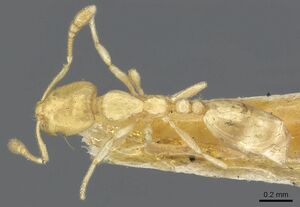Monomorium braunsi
| Monomorium braunsi | |
|---|---|

| |
| Scientific classification | |
| Kingdom: | Animalia |
| Phylum: | Arthropoda |
| Class: | Insecta |
| Order: | Hymenoptera |
| Family: | Formicidae |
| Subfamily: | Myrmicinae |
| Tribe: | Solenopsidini |
| Genus: | Monomorium |
| Species: | M. braunsi |
| Binomial name | |
| Monomorium braunsi Mayr, 1901 | |
Nothing is known about the biology of Monomorium braunsi.
Identification
Bolton (1987) - A member of the M. boerorum complex in the M. monomorium species group. This minute yellow species is distinguished from its close relatives Monomorium mavide, Monomorium musicum and Monomorium torvicte by its very reduced alitrunk pilosity and low broadly rounded petiole node. The subpetiolar process of braunsi is very reduced, being represented only by a low anteroventral prominence rather than the anteriorly truncated longitudinal cuticular strip seen in the other three species mentioned.
Keys including this Species
Distribution
Latitudinal Distribution Pattern
Latitudinal Range: -20.16667° to -31.37418°.
| North Temperate |
North Subtropical |
Tropical | South Subtropical |
South Temperate |
- Source: AntMaps
Distribution based on Regional Taxon Lists
Afrotropical Region: South Africa (type locality).
Palaearctic Region: China.
Distribution based on AntMaps
Distribution based on AntWeb specimens
Check data from AntWeb
Countries Occupied
| Number of countries occupied by this species based on AntWiki Regional Taxon Lists. In general, fewer countries occupied indicates a narrower range, while more countries indicates a more widespread species. |

|
Estimated Abundance
| Relative abundance based on number of AntMaps records per species (this species within the purple bar). Fewer records (to the left) indicates a less abundant/encountered species while more records (to the right) indicates more abundant/encountered species. |

|
Biology
Castes
Images from AntWeb

| |
| Syntype of Monomorium braunsi. Worker. Specimen code casent0902263. Photographer Ryan Perry, uploaded by California Academy of Sciences. | Owned by NHMUK, London, UK. |
Nomenclature
The following information is derived from Barry Bolton's Online Catalogue of the Ants of the World.
- braunsi. Monomorium braunsi Mayr, 1901b: 7 (w.) SOUTH AFRICA.
- Type-material: syntype workers (number not stated).
- Type-locality: South Africa: Port Elisabeth (H. Brauns).
- Type-depositories: BMNH, NHMW.
- Status as species: Arnold, 1916: 234; Emery, 1922e: 171; Wheeler, W.M. 1922a: 863; Ettershank, 1966: 88; Bolton, 1987: 382 (redescription); Bolton, 1995b: 260; Guénard & Dunn, 2012: 45 (error?).
- Distribution: South Africa.
Unless otherwise noted the text for the remainder of this section is reported from the publication that includes the original description.
Description
Worker
Bolton (1987) - TL 1.6, HL 0.43, HW 0.33, CI 77, SL 0.27, SI 82, PW 0.20, AL 0.44.
Clypeal carinae of this minute species short, clearly visible only on central third of length of median portion of clypeus, fading out both anteriorly towards the free margin and posteriorly between the antennal insertions. Anterior clypeal margin evenly convex across central portion, without conspicuous angles or denticles separating the anterior and lateral borders of the median prominent section of the clypeus. Eyes relatively small, only 0.18 x HW and with 5 ommatidia in the longest row. In full-face view the eyes very distinctly in front of the midlength of the sides of the head. Antennal scapes, when laid straight back from their insertions, falling far short of the occipital margin. Sides of head very shallowly convex in full-face view and divergent posteriorly from front to back so that the width across the occiput is obviously greater than the width across the clypeus. Occipital margin nearly transverse, with only the feeblest hint of concavity medially. Head in profile dorsoventrally compressed, the ventral surface more convex than the dorsal. Promesonotum low and only weakly convex in profile, the metanotal groove very shallowly impressed and traversed by short cross-ribs. Propodeal dorsum shallowly convex and rounding broadly into the declivity. Propodeal spiracle minute and pinhole-like. Petiole with a short stout anterior peduncle, the latter with a small inconspicuous anteroventral process. Node of petiole low and broad in profile, broadly rounded above and with a bulging convex ventral border. Postpetiole smaller and lower than the petiole, its dorsal surface somewhat more broadly rounded. Cephalic dorsum with several pairs of standing hairs but alitrunk with only a single pair, situated at the pronotal humeri. Petiole, postpetiole and gaster all with standing hairs visible. Sculpture absent except for minute hair-pits and metanotal cross-ribs. Colour uniformly yellow.
Type Material
Bolton (1987) - Syntype worker, South Africa: Port Elizabeth (H. Brauns) (The Natural History Museum) [examined].
References
- Bolton, B. 1987. A review of the Solenopsis genus-group and revision of Afrotropical Monomorium Mayr (Hymenoptera: Formicidae). Bulletin of the British Museum (Natural History). Entomology. 54: 263-452.. (page 382, see also)
- Mayr, G. 1901b. Südafrikanische Formiciden, gesammelt von Dr. Hans Brauns. Ann. K-K. Naturhist. Mus. Wien 16: 1-30 (page 7, worker described)
References based on Global Ant Biodiversity Informatics
- Arnold G. 1916. A monograph of the Formicidae of South Africa. Part II. Ponerinae, Dorylinae. Annals of the South African Museum. 14: 159-270.
- Bolton B. 1987. A review of the Solenopsis genus-group and revision of Afrotropical Monomorium Mayr (Hymenoptera: Formicidae). Bulletin of the British Museum (Natural History). Entomology 54: 263-452.
- Ettershank G. 1966. A generic revision of the world Myrmicinae related to Solenopsis and Pheidologeton (Hymenoptera: Formicidae). Aust. J. Zool. 14: 73-171.
- Guénard B., and R. R. Dunn. 2012. A checklist of the ants of China. Zootaxa 3558: 1-77.
- Huang Jian-hua, Zhou Shan-yi. 2007. A checklist of family Formicidae of China - Myrmicinae (Part II) (Insecta: Hymenoptera). Journal of Guangxi Normal University : Natural Science Edition 25(1): 91-99.
- IZIKO South Africa Museum Collection
- Kusnezov N. 1949. El género Monomorium (Hymenoptera, Formicidae) en la Argentina. Acta Zoologica Lilloana 7: 423-448.

